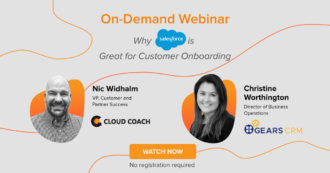 Webinar
Webinar
- Solutions
- Customer Onboarding
- Customer Success
- Professional Services Automation
- Project Management
- Project Portfolio Management
-
Solutions
-
Features
- Why Cloud Coach
- Customers
-
Resources

Unfortunately, not every customer is going to experience success with your product or service. Some customers will inevitably have trouble working out how to use it, run into technical issues, or simply dislike a few elements of your business.
By focusing as much as you can on customer success strategies, you’ll be able to minimize the amount of customer “failures” your business experiences—but it doesn’t hurt to prepare for those eventualities. So in this section, we’ll show you what to do in these instances of customer failures.
Robust customer support
Having great customer support is part of an overall customer success strategy, however, it’s also the first line of defense when customers experience failure.
Other than having customer support available whenever the customer needs it, there are a few other ways to give the customer an experience above and beyond what they expect, including:
- Make support available in their native language. Having multiple languages within your customer support team is one of the best ways to help a customer feel more able to express themselves and their issues correctly.
“Speaking the same language as our customers is crucial for clear communication. We provide support in eight languages. What is essential, English language support is available 24/7.” — Małgorzata Mikulska, Customer Success Director at GetResponse
- Multimedia support. Explaining complex issues using words alone can be intimidating and confusing for some customers, who end up more frustrated than when they entered the conversation. Having a photo or video explainer can be a great way of offering support for technical issues.
“We often use tools such as Cleanshot to record short video guides for our customers if it helps solve their problems. Using videos has been pretty effective so far, and it makes it very easy for us to explain the steps needed to solve the reported issue. The customer can reuse the video instruction as many times as needed.” — Małgorzata Mikulska
- Give support fast. Customers expect quick responses when they’re facing an issue. According to research from HubSpot, 90% of customers rate an “immediate” customer service response as important or very important to them. So offering fast support during a customer’s failure can help improve the experience.
“Response time is critical: when someone is inspired to set up their email automation, we don’t want that inspiration to fizzle out.” — Jane Portman, Founder of Userlist
These “in the front line” responses can help turn a customer failure into a customer success story in the first instance. However, over the long term, your business may want to consider the remaining tips below.
ADDITIONAL LINKS
Improve internal communication
A more long-term preventative measure against customer failure is improving internal communication.
In her book “The Silo Effect” Gillian Tett uncovers how “silo’s”—a term used to describe how a person or business departments that are “trapped inside their little specialist departments, social groups, teams, or pockets of knowledge”—hinders workplace communication and increases risks of organizational failure.
To overcome this “silo effect”, which can cause customer failures from lack of proper interdepartmental communication, your business should embrace better internal communication tools and strategies.
Reflecting on this, Małgorzata says:
“Every employee coming to GetResponse is aware of the importance of customer feedback. We have established special Slack channels for communication between the customer success team and other departments.
Suppose a client mentions that they are missing a feature or that one of the features is not working properly. In that case, the Customer Success Advisor immediately passes this information via the appropriate communication channel. If it’s something that we can fix quickly, we do it.
If it’s something that can’t be fixed here and now, we take their feedback and think about how we can improve our customers’ experience, so this failure doesn’t happen again. Our tool keeps constantly evolving thanks to our customers’ feedback.”
Making sure that different departments can communicate with each other effectively means customers can get the most appropriate response to their failures. Whether that be bug fixes, discounts, or a product feature suggestions page/forum.
Review your customer success strategies
If your business is suffering from consistent complaints or overall customer failure, especially if it’s not centered around a specific part of the product or service, you might want to review your customer success strategy from the ground up.
There are a few common mistakes businesses make when building their customer success strategy, including:
- Not putting the customer first. You might think it’s difficult for customer success teams to not put the customer first. However, it can be easy to fall into either complacency regarding treating customers the same (instead of offering tailored solutions), or rushing customers with up-selling or cross-selling before they might want or need it.
- Not having defined success goals. Another easy mistake to make is setting up metrics to track your customer’s success or milestones, but not having any clearly defined goals to measure those metrics against. When your CS team has defined goals to achieve with your customers, it helps remove any ambiguity moving forwards.
- Thinking no feedback = satisfied customers. A common saying in English-speaking countries is “no news is good news”—however, this couldn’t be further from the truth in customer success. According to recent research, only 35% of customers say they contact the business directly about an issue, others will just churn away in silence.
- Targeting the wrong customers. You can’t be the right product or service for everyone—a common mistake is that your business may be attracting ill-fitting customers, or trying to say “yes” to all leads. CS managers should work closely with sales and account managers to determine when to accept an account and when to cut ties.
If your business has fallen into any of the above common mistakes, the root fault likely lies within your customer success strategy and is worth reviewing to adjust or correct these mistakes.
Get the right tools for the job: customer success software
Once upon a time, businesses would have had to create some form of customer success strategy, monitor, and maintain it manually. At least in current times, there are digital tools around that help you not only get the job done, they boost your efforts too.
Throughout this guide, we’ve mentioned several different tools and services that can help you achieve your customer success goals, including:
- Toggl Track for time tracking.
- Userpilot for milestone tracking.
- Brand Mentions for social listening.
- Survey Monkey for feedback surveys.
Adopting each of these tools can help, but your business runs the risk of not having these tools “talk” to each other to gain better or more helpful insights and results. You would have to resort to using more third-party tools such as Zapier to integrate some of these tools (if the integrations are available in the first place).
But there are better solutions—an all-in-one project management tool such as Cloud Coach can help keep everything “under one roof”. With an all-in-one tool, you won’t need to worry about getting tools to communicate with each other, or porting data over to different tools to gain the insights your business needs.
Cloud Coach offers customer success teams several benefits, such as:
- Stakeholder documentation. Capture the key stakeholders whose input will be needed to make your projects and initiative successful, and display them in an organizational tree view, so it’s easy for everyone to know where everyone fits in.
- Capturing and monitoring customer goals. If you’re not mapping your efforts towards your customers’ goals, what value are you really bringing them? With Cloud Coach, you can track your clients, goals, and requirements right through from workshops to deployed solutions.
- Milestone tracking. Create one or more milestone processes for your business and apply them to your project templates, so you get accurate insight into where each project is in your process at any time.
- Time tracking. User-friendly time tracking, is designed to let your users enter time in multiple ways so that they enter their time easily and you get accurate data to report on.
- Documents and meetings. Capture all your project documentation in one place, so your team always knows where to find the right piece of information.
- Risks, issues, and change request management. No matter how well planned your project is, not everything is going to go to plan, so you need a way to manage all the extra balls that get thrown at you.
- Intuitive reports and dashboards. All the data your team captures with Cloud Coach can be reported upon 24 hours a day, 7 days a week from anywhere in the world.
While Cloud Coach offers great customer onboarding, that’s just the beginning of your customer success journey. Cloud Coach can help you manage the success of your customers throughout their customer journey.
Want to maximize the efficiency of your customer success team with intuitive project management software?
Reach out to our team to schedule your own personalized demo today.
Helpful Resources
See Cloud Coach In Action
We’d be happy to provide a bespoke 1:1 demo on how Cloud Coach can benefit for your business.























